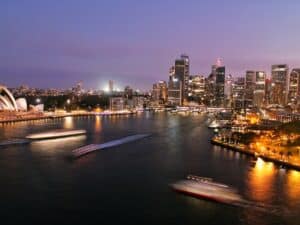When you think about leaving Australia for good, excitement and apprehension might fill your mind. Many Australians become expats for various reasons, from career opportunities to personal adventures.
Recently, we’ve noticed an increasing trend of Australians moving abroad. This guide aims to provide you with essential tips to ensure you make informed decisions when leaving Australia for good.
If you want to invest as an expat or high-net-worth individual, you can email me (advice@adamfayed.com) or use these contact options.
Table of Contents
Financial Preparations Before Leaving Australia for Good
Leaving Australia for good requires meticulous financial planning. Your financial decisions can significantly impact your transition and life as an expat. Here’s a detailed guide to help you make informed choices:
Bank Accounts: To Close or Not to Close?
When you’re on the verge of leaving Australia for good, one of your first decisions is whether to close or maintain your Australian bank accounts.
Retaining an Australian bank account can be beneficial, especially if you have ongoing financial commitments. It offers the convenience of accessing funds for any Australian-based expenses.
However, it’s essential to be aware of international banking fees that might apply when accessing your funds from overseas or transferring money between countries.
Benefits of Keeping an Australian Bank Account:
- Ease of managing any remaining financial obligations in Australia.
- Potential for better interest rates on savings.
- Simplified the process if you decide to return to Australia in the future.
Drawbacks of Keeping an Australian Bank Account:
- Possible account maintenance fees for non-residents.
- International transaction fees when accessing funds.
- Exchange rate fluctuations can affect your account balance when converting currencies.
Navigating the Australian Tax Landscape
Understanding the Australian tax implications is paramount when leaving Australia for good. Your tax obligations can change based on your residency status and the nature of your income.
Determining Your Residency for Tax Purposes:
Your tax residency determines how the Australian Taxation Office (ATO) will treat your income.
If the ATO considers you an Australian resident for tax purposes, you’ll be taxed on your worldwide income. However, if you’re deemed a non-resident, you’ll only be taxed on your Australian-sourced income.
Reporting Overseas Income
If you retain your Australian tax residency status after leaving Australia for good, you must report all overseas income. This includes salaries, rental income, and any capital gains. It’s crucial to keep detailed records and seek advice from a tax professional to ensure compliance.
Capital Gains Tax (CGT) Considerations
When leaving Australia for good, any assets you own, such as property, might be subject to CGT. The ATO deems you to have sold some assets even if no sale took place. Understanding these “deemed disposals” and their implications on your tax obligations is essential.
Seeking Professional Advice
Given the complexities of financial preparations when leaving Australia for good, consulting with a financial advisor or tax professional can be invaluable.
They can provide tailored advice, ensuring you make decisions that align with your financial goals and comply with all regulatory requirements.
Health and Insurance Considerations
When contemplating leaving Australia for good, prioritizing your health and insurance coverage is paramount.
The transition from Australia’s healthcare system to another country’s can be complex, and understanding these nuances is essential for a smooth move.
Transferring Your Australian Health Insurance
If you currently benefit from health insurance in Australia, it’s worth considering a transfer to an international provider.
Many Australians leaving Australia for good often overlook the potential gaps in coverage that can arise when moving abroad.
It’s essential to research recognized health insurance providers in your new country and understand the specifics of their offerings.

Securing International Health Insurance
For many, leaving Australia for good means venturing into international health insurance.
It’s not just about finding a new provider; it’s about comparing policies, understanding the terms, and ensuring you’re adequately covered for your needs.
The local healthcare systems can vary significantly from Australia’s, so familiarize yourself with the healthcare landscape of your new country.
Travel Health Advice for Australians
Researching Your Destination
Understand the health risks you might face in your new country. This includes infectious diseases, local attitudes towards mental health, and the availability of medications.
Importance of Travel Insurance
Health coverage is a primary reason Australians secure travel insurance. Medical assistance overseas can be costly, and you might find yourself in a financial bind without insurance. Ensure your policy covers your specific needs and activities.
Consultation with Your Doctor
Your GP can offer personalized advice based on your health needs. They can guide you on necessary vaccinations and potential health risks in your destination and provide preventative advice.
Vaccinations and Preventative Health
Prevention remains better than cure. Understand the vaccinations you might need for your destination and any preventative measures you can take to reduce health risks.
Medication and Medical Supplies
If you rely on specific medications, stock up before leaving Australia for good. Some medications might not be available in your new country, or they might even be illegal.
Always keep medications in their original packaging and carry a prescription or a letter from your doctor explaining the necessity of the medication.
Activities and Their Impact on Health
The activities you plan to engage in overseas can influence your health. Understanding the potential health implications is crucial, whether it’s adventurous endeavors or simple leisure activities.
For instance, if you’re considering medical tourism, choosing hospitals and surgeons wisely is essential, as standards can vary.
Property and Asset Management
Leaving Australia for good brings forth a myriad of decisions, especially concerning your assets. One of the most significant decisions revolves around property ownership.
Selling vs. Renting Out Your Australian Property
When leaving Australia for good, homeowners often grapple with the decision to sell or rent out their property. Both options come with their own set of advantages and challenges:
Selling Your Property
- Immediate Liquidity: Selling provides immediate funds that can be useful for your relocation or other investments.
- No Property Management Hassles: You won’t have to worry about tenants, maintenance, or other property-related concerns from abroad.
- Market Conditions: If the property market is strong, selling might fetch you a good price.
Renting Out Your Property
- Steady Income Stream: Renting can provide a consistent source of income, especially if the rental market is robust.
- Property Appreciation: If property values are rising, holding onto your property might result in higher future valuations.
- Flexibility: If you ever decide to return, your property remains available to you.
Collaborating with Real Estate Professionals
Current Market Analysis
Understand the current property market trends and how they might affect your decision.
Property Valuation
Get an accurate valuation of your property to set realistic expectations.
Hassle-free Management
If you opt to rent, property managers can handle tenant issues, maintenance, and other responsibilities on your behalf.

Managing Other Assets and Investments
Superannuation Funds
Research the implications of transferring or leaving your superannuation funds overseas in Australia. Some countries have agreements with Australia that can affect your super when you move.
International Investment Opportunities
As you settle in a new country, explore the investment avenues available. Diversifying your investments can offer both security and growth potential.
Legal and Documentation Essentials
Keeping Australian Documents Updated
Passports
Regularly check the expiration date. Renew it if you’re close to the expiry, as many countries require a minimum validity for entry.
Driver’s Licenses
Check the international driving permit requirements if you plan to drive in your new country. Some countries accept Australian licenses, while others might require a translation or an international permit.
Other IDs
Always keep a digital copy of all your identification documents. This can be a lifesaver if you lose them or need them in emergencies.
Power of Attorney
Having a power of attorney is crucial when leaving Australia for good. This legal document allows someone you trust to decide on your behalf, especially concerning financial matters or health decisions. It ensures that, even from abroad, your interests in Australia remain protected.

Visa and Residency Requirements
Research Visa Types
From work visas to retirement visas, each country offers various options. Choose the one that aligns with your purpose of stay.
Permanent Residency vs. Temporary Stays
Understand the benefits and limitations of each. Permanent residency often comes with more rights but might have stringent requirements.
Local Legal Support
Consider consulting a local immigration lawyer or agency in your new country. They can provide insights specific to your situation and help streamline the process.
Staying Informed
The rules and regulations can change. Even after leaving Australia for good, regularly check both Australia and your new country’s official websites for any updates. This proactive approach ensures you remain compliant and can make informed decisions based on the latest information.
Navigating Local Transportation
Understanding Public Transport Systems
- Research the Main Modes of Transport: Whether it’s the metro in Paris, trams in Amsterdam, or the tuk-tuks in Bangkok, every city has its unique modes of transport. Familiarize yourself with these options to choose the most convenient for your daily commute.
- Get Acquainted with Schedules and Routes: Most cities offer apps or websites that provide real-time updates on schedules. These tools can be invaluable, especially during the initial days when you’re still finding your way around.
- Learn About Payment Methods: Payment methods can vary from contactless cards to mobile apps. Ensure you have the right tools to pay, be it a transportation card or a mobile payment app.
Driving in a New Country: Licenses and Regulations
- Check License Validity: Some countries allow you to drive with an Australian license for a specific period, while others might require an international driving permit. Research the requirements of your new country to ensure you’re compliant.
- Understand Local Driving Rules: Every country has its driving norms, from which side of the road to drive on to specific road signs. Familiarize yourself with these rules to ensure safety.
- Consider Renting Before Buying: Before committing to buying a vehicle, consider renting. This allows you to understand the driving conditions and decide if driving is the best option for you.
Alternative Modes of Transport
- Embrace Local Alternatives: In cities like Beijing, bicycles are a popular mode of transport. In Venice, you might find yourself on a gondola. Embracing these local alternatives can enrich your experience.
- Shared Mobility Solutions: Car-sharing platforms, bike rentals, and e-scooters have become popular in many cities. They offer flexibility and can often be more economical than owning a vehicle.
- Walking Tours: One of the best ways to familiarize yourself with a new city is by walking. Consider joining walking tours during your initial days. It’s a great way to learn about the city’s history, culture, and key landmarks.
Discovering Local Cuisine and Dietary Adjustments
Sampling Local Delicacies
Every region boasts its unique flavors, ingredients, and cooking techniques. As you venture out in your new home, make it a point to try local dishes.
Adapting to New Dietary Norms
Every country has its set of dietary norms and preferences. If you have specific dietary restrictions or preferences, learning how to communicate them in the local language is essential. This ensures that you can enjoy meals without concerns.

Finding Australian Food Overseas
Leaving Australia for good might sometimes lead to cravings for a taste of home. Fortunately, our globalized world ensures that Australian food isn’t too hard to find, no matter where you are.
Many cities worldwide have Australian restaurants or cafes that serve classic dishes like meat pies, lamingtons, or even a good old flat white.
Additionally, some specialty stores import Australian goods, allowing you to whip up your favorite Aussie meal right in your new kitchen.
Pained by financial indecision? Want to invest with Adam?

Adam is an internationally recognised author on financial matters, with over 760.2 million answer views on Quora.com, a widely sold book on Amazon, and a contributor on Forbes.



